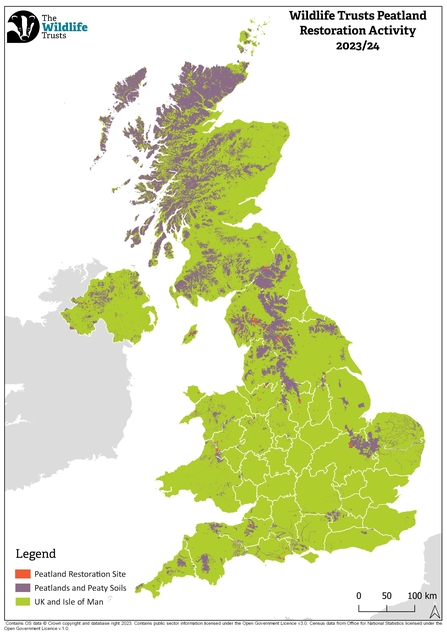Peatland restoration is an essential part of the UK’s pathway to decarbonisation. Nature is the only mechanism of removing carbon dioxide from the atmosphere in this country at present, mainly through woodland ecosystems and also healthy peatlands. When in good condition, in a waterlogged or re-wetted state, peatlands are a wildlife hotspot; home to rare plants like sundews and cotton grass, butterflies like the marsh fritillary, and beautiful birds like the golden plover.
Peatlands hold enormous amounts of carbon in their soils; around 3.2 billion tonnes across the UK. But 80% are in poor condition, and are releasing rather than capturing carbon. Around 20 million tonnes of greenhouse gases (4% of total UK emissions) is being emitted each year. If the UK is going to reach net zero greenhouse gas emissions, this needs to stop, and the carbon stored within peatlands to be protected from further losses.
Getting peatland emissions down is part of the UK Government’s Net Zero Strategy, but to date both the Department for Energy Security and Net Zero (DESNZ) and the Climate Change Committee (CCC) have been warning that the level of restoration is far too low. The Climate Change Committee in its last progress report recommended to UK Government that restoration rates need to be around 67,000 hectares per year across England, Wales and Scotland by 2025. The UK Government has set itself a much lower target of 32,000 hectares per year. By the Climate Change Committee’s latest count, only 12,700 hectares came under restoration in 2022/23; way below both interim targets.
However, the amount of restoration being counted seems out of step with the activity we know is underway. The Climate Change Committee rely on what’s in the UK greenhouse gas inventory, and what UK Government says it’s doing on current restoration effort. For England, data comes from the Nature for Climate Fund, plus figures supplied direct by Scottish and Welsh governments, with no data made available from Northern Ireland. It is difficult to track this data and exactly which peatland information makes it through.
We now have detailed information on the peatland restoration happening across The Wildlife Trusts, however, revealing that:
-
Since 2008, The Wildlife Trusts have brought 60,000 hectares of peatland under restoration across England, Wales and Northern Ireland – on our own land and in partnership with others1
-
We received £45.5 million in funding for this restoration work, half of which has come in since 2021 – showing that the rate of investment is increasing
-
Government funding is an important source of support, but is by no means the only income for our peatland restoration work: £13.4 million, almost a third, was from non-government sources.
-
We can show evidence of peatland restoration in Northern Ireland, which is missing altogether from UK Government figures. Ulster Wildlife has around 500 hectares under restoration already and are looking to scale up activity significantly in the next few years
The main issue with UK Government numbers that we spotted is that for England, only direct government support from one funding steam is being counted; the Nature for Climate Fund. The Wildlife Trusts have received £6.8 million from this fund to date, all since 2021. But over this time period, Wildlife Trusts in England also received £6.7 million towards peatland restoration through other UK Government sources such as agri-environment schemes, and another £5.6 million on top from private, non-government funders including water companies, EU and philanthropic grants. This immediately suggests that using Nature for Climate Fund as a proxy for total restoration funding and effort in England is far too limited. Most of the Climate Coalition Committee’s estimated 12,700 hectares of restoration effort in 2022/23 came through support from this fund, meaning on the basis of the funding split, there could be at least that much restoration again that is not being counted at all. If that is the case, current total peatland restoration effort could be much closer to the UK Government’s 32,000 hectare target.



